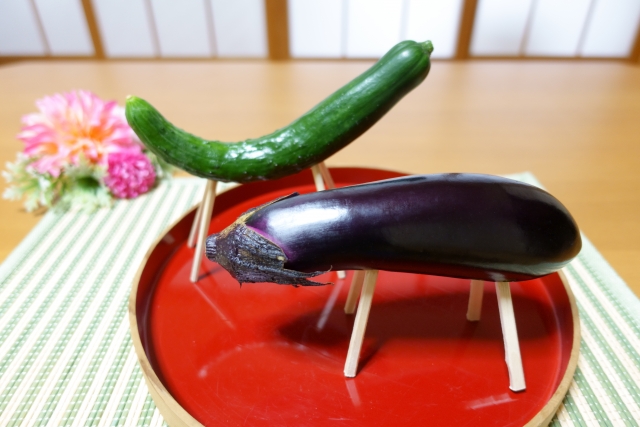You might have heard that the Japanese are organizing summer festival (夏祭り) every year. There are different kinds of summer festivals, and “Obon” (お盆) is one of them. Do you know anything about “Obon”?
“Obon” (お盆)
“Obon” (お盆), also named”urabone” (盂蘭盆会), arises from the Buddhist ceremony. “Obon” was first held during the Asuka period (飛鳥時代 Asuka jidai), which has a history of about 1400 years. It became a unique Japanese traditional festival for ancestors worship after a thousand years. Before Meiji Period (明治時代 Meiji jidai) “Obon” was held on the 15th July of the lunar calendar, but now people stick to the solar calendar that “obon” is held mainly between 13-16th July or August every year, depending on regions.
What do people do in “Obon”?
1. Shouryou Uma (精霊馬)
Japanese welcome the spirits of ancestors home during every-year “Obon”. Japanese will use eggplant and cucumber to make a horse called “shouryou uma” (精霊馬) for taking their ancestors’ spirits home. “Shouryou uma” literally means “the horse of spirits.”

2. Bon Dance (盆踊り)
“Bon Dance” (盆踊り Bon Odori) is also part of this “Obon” tradition. Again, they dance for their ancestors and the music and style varies across Japan. The Gujō Odori (郡上踊り) of Gifu Prefecture, the Awa Odori (阿波踊り) of Tokushima Prefecture, and the Nishimonai no Bonodori (西馬音内の盆踊り) of Akita Prefecture are the three most famous “Bon Dance” in Japan. Let’s see below the Gujō Odori as an example.
岐阜県郡上踊り
これは1700年代から続いてる?もっと古い??
とにかく凄い歴史だ(+_+) pic.twitter.com/8RNr3ElTGR— KAZUYA (@KAZUYA_RV) January 16, 2020
3. Mukaebi (迎え火) & Okuribi (送り火)
They will also make a welcoming fire call “mukaebi” (迎え火) in “Obon.” “Mukae” means “welcome” in Japanese so the fire is to welcome their ancestors back.
Hoy es 13 de julio y en Japón es el Día del fuego de bienvenida para los espíritus (盆迎え火). Ya empiezan los preparativos para la festividad del Obon y hacemos la forma de caballo con batatas o berenjenas. En el pueblo de mi abuela lo hacíamos cuando era pequeña
pic.twitter.com/LXtQ3xmZLv
— Japón con jamón
(@NekoJitaBlog) July 13, 2020
Opposingly, they also make an “Okuribi,” which means fire to send them back, at the end of “Obon” to send their ancestors back. “Okuribi” can be categorized into two types, “Okuribi in the mountain” (山の送り火) and “Okuribi in the sea” (海の送り火). This custom differs across Japan as well. Kyoto is famous for both sending some lanterns onto the river and making fire on the hill.
https://twitter.com/misapon925/status/906145539279826947
https://twitter.com/lBwb2VB8sPxM9LL/status/1283496127522762752
“Obon” is a Japanese tradition for memorizing and worshiping their ancestors. Recently, it became a more joyful and famous festival among Japanese and travellers. I guess you will enjoy the atmosphere very much so go and check it out if you visit Japan during summer!


